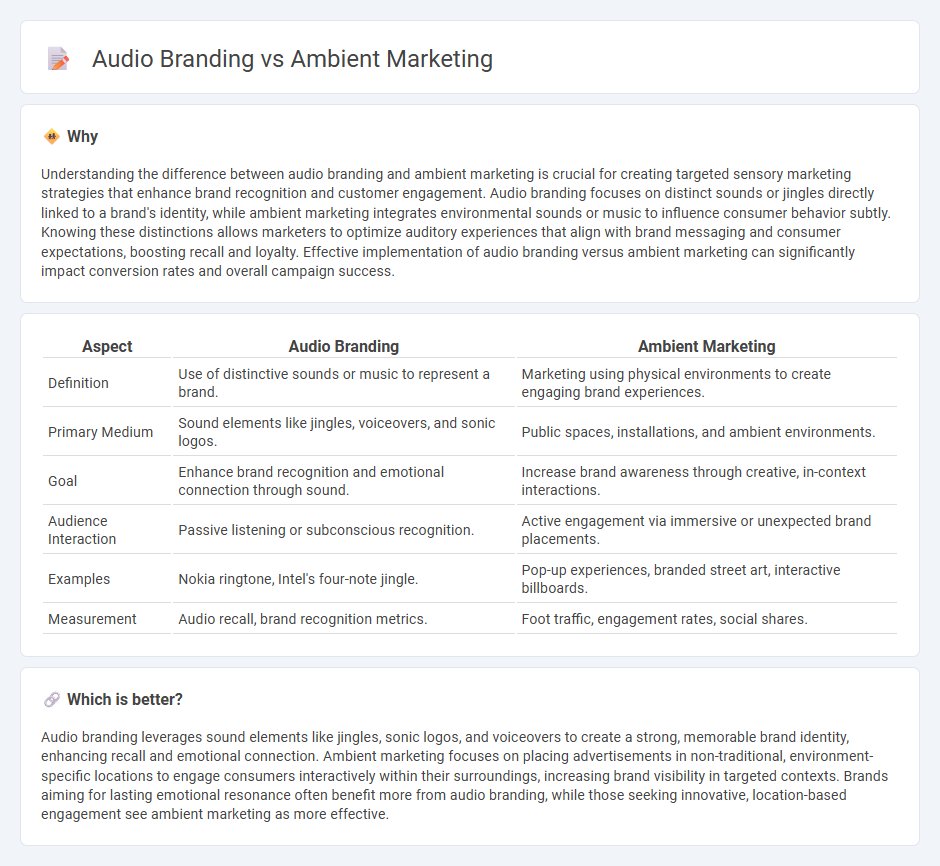
Audio branding leverages distinctive sounds, jingles, or voice elements to create a recognizable identity that enhances brand recall and emotional connection. Ambient marketing utilizes environmental elements and subtle sensory cues to engage consumers without overt advertising, fostering immersive brand experiences in physical or digital spaces. Explore more to understand how these innovative strategies can amplify your marketing impact.
Why it is important
Understanding the difference between audio branding and ambient marketing is crucial for creating targeted sensory marketing strategies that enhance brand recognition and customer engagement. Audio branding focuses on distinct sounds or jingles directly linked to a brand's identity, while ambient marketing integrates environmental sounds or music to influence consumer behavior subtly. Knowing these distinctions allows marketers to optimize auditory experiences that align with brand messaging and consumer expectations, boosting recall and loyalty. Effective implementation of audio branding versus ambient marketing can significantly impact conversion rates and overall campaign success.
Comparison Table
| Aspect | Audio Branding | Ambient Marketing |
|---|---|---|
| Definition | Use of distinctive sounds or music to represent a brand. | Marketing using physical environments to create engaging brand experiences. |
| Primary Medium | Sound elements like jingles, voiceovers, and sonic logos. | Public spaces, installations, and ambient environments. |
| Goal | Enhance brand recognition and emotional connection through sound. | Increase brand awareness through creative, in-context interactions. |
| Audience Interaction | Passive listening or subconscious recognition. | Active engagement via immersive or unexpected brand placements. |
| Examples | Nokia ringtone, Intel's four-note jingle. | Pop-up experiences, branded street art, interactive billboards. |
| Measurement | Audio recall, brand recognition metrics. | Foot traffic, engagement rates, social shares. |
Which is better?
Audio branding leverages sound elements like jingles, sonic logos, and voiceovers to create a strong, memorable brand identity, enhancing recall and emotional connection. Ambient marketing focuses on placing advertisements in non-traditional, environment-specific locations to engage consumers interactively within their surroundings, increasing brand visibility in targeted contexts. Brands aiming for lasting emotional resonance often benefit more from audio branding, while those seeking innovative, location-based engagement see ambient marketing as more effective.
Connection
Audio branding leverages distinctive sound elements to create a memorable brand identity, while ambient marketing integrates sensory experiences, including sound, into physical spaces to engage consumers. Both strategies use auditory cues to enhance brand recognition and emotional connection, driving deeper consumer engagement. By combining audio branding with ambient marketing, companies create immersive environments that reinforce brand messaging and influence purchasing behavior.
Key Terms
**Ambient Marketing:**
Ambient marketing leverages unconventional physical environments to create memorable brand experiences, often integrating digital and sensory elements to capture consumer attention in everyday settings. This strategy emphasizes contextual relevance, using locations such as public transport, shopping centers, or urban spaces to engage audiences non-intrusively and enhance brand recall. Explore how ambient marketing can transform your brand presence through innovative, location-based campaigns.
Guerrilla Advertising
Ambient marketing leverages unexpected, context-driven environments to create memorable brand experiences, while audio branding uses sound elements like jingles and sound logos to establish brand identity. Guerrilla advertising combines these strategies by deploying unconventional, sensory-rich campaigns--often using ambient spaces enhanced with distinctive audio--to capture audience attention and foster emotional connections. Explore how integrating ambient marketing with audio branding strategies in guerrilla advertising can amplify brand recall and engagement.
Contextual Placement
Ambient marketing leverages physical environments to create immersive brand experiences through strategic contextual placement in public spaces, retail locations, or events, enhancing consumer engagement by blending seamlessly with surroundings. Audio branding focuses on creating distinctive sound identities tailored to specific contexts, such as retail atmospheres or digital platforms, to reinforce brand recognition and emotional connection. Explore more to understand how contextual placement drives the effectiveness of both ambient marketing and audio branding strategies.
Source and External Links
What is Ambient Marketing: Advantages and Examples - Ambient marketing promotes products by placing creative ads in unusual locations, engaging emotions, and increasing brand awareness through memorable, shareable campaigns.
Ambient Advertising: Strategies to Capture Consumer Attention - This approach places ads in everyday, unexpected settings to create high visibility, cost-effectiveness, and memorable, non-intrusive brand experiences.
What is ambient marketing? - Ambient marketing relies on creativity, surprise, engagement, and subtlety to stand out and build a memorable connection with audiences in unexpected places.
 dowidth.com
dowidth.com